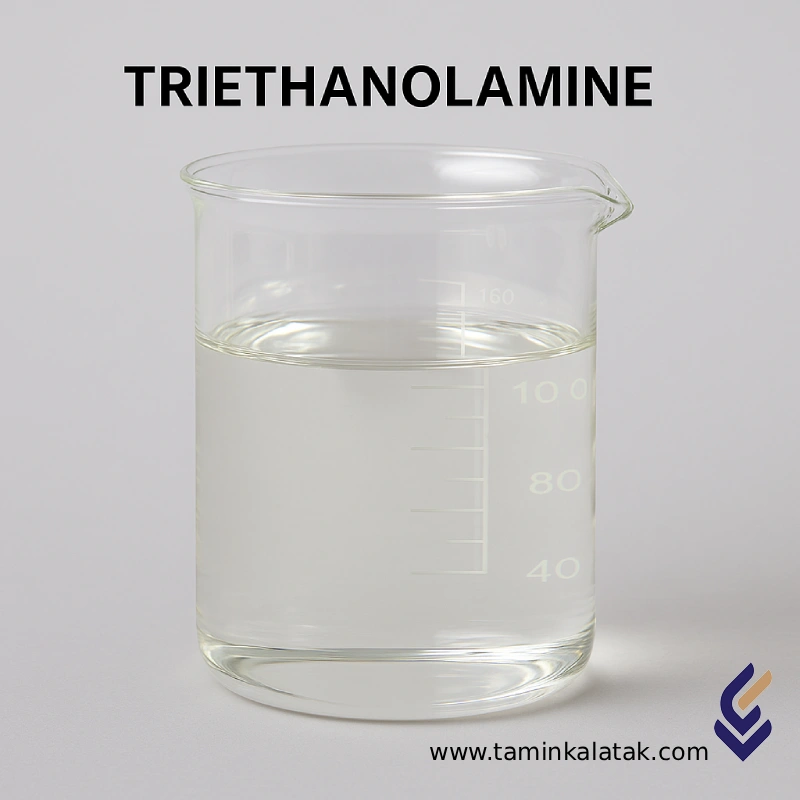Tri Ethanol Amine
Triethanolamine (TEA) is an organic compound with the chemical formula C₆H₁₅NO₃, classified as a tertiary amine and a tri-hydric alcohol.
It is produced by the reaction of ethylene oxide with ammonia, and contains three hydroxyl (-OH) groups and one tertiary amine (-N<) functional group.
Molecular Structure:
HO–CH₂–CH₂–N(CH₂CH₂OH)₂
This structure enables TEA to act as a weak base, emulsifier, pH stabilizer, and strong solvent in various formulations.
Physical and Chemical Properties
| Property | Value / Description |
|---|---|
| Appearance | Clear, colorless to pale yellow viscous liquid |
| Odor | Mild, ammoniacal, slightly sweet odor |
| Molecular Weight | 149.19 g/mol |
| Boiling Point | 335 – 335.4°C |
| Melting Point | ~21.2 – 21.6°C |
| Density (25°C) | 1.124 – 1.127 g/cm³ |
| Viscosity (25°C) | ~450 cP (relatively high) |
| Solubility | Completely miscible with water, ethanol, and acetone |
| pH (1% aqueous solution) | 10.5 – 11.5 |
Applications
1. Cosmetics and Personal Care
-
pH adjuster in creams and lotions
-
Emulsifying agent in shampoos and shaving gels
-
Foam booster in mild cleansing formulations
2. Oil, Gas, and Drilling
-
Corrosion inhibitor in oil and gas transportation systems
-
Additive in drilling fluids
3. Textile Industry
-
Lubricant and softening agent in dyeing and finishing processes
-
Dye fixative for synthetic fibers
4. Pharmaceuticals
-
Base for ointments, creams, and topical formulations
-
Used in slow-release tablet formulations
5. Paints, Inks, and Coatings
-
Viscosity stabilizer and pH regulator
-
Improves dispersion and prevents pigment settling
6. Cement and Construction
-
Grinding aid in cement production
-
Enhances workability and strength of concrete
Advantages
-
Excellent buffering capacity for pH control
-
High solubility in both aqueous and organic systems
-
Multifunctional — acts as solvent, surfactant, and complexing agent
-
Suitable for low-odor and non-irritating formulations
Disadvantages
-
May cause skin sensitization upon repeated contact
-
Limited thermal stability at elevated temperatures
-
Requires precise dosage control in cosmetic formulations
-
Potential to form nitrosamines in the presence of nitrites under certain conditions
Safety and Handling
GHS Classification:
-
H315: Causes skin irritation
-
H319: Causes serious eye irritation
-
H335: May cause respiratory irritation
Safety Precautions (HSE):
-
Use protective gloves, safety goggles, and ensure adequate ventilation
-
Avoid direct contact with skin and eyes, and prevent inhalation of vapors
-
Store in tightly closed containers at ambient temperature, away from direct sunlight
Transportation Information:
-
UN Number: 2491
-
Hazard Class: 8 (Corrosive substances)
Summary
Triethanolamine (TEA) is a versatile, multifunctional chemical widely used in formulation, refining, textile, and construction industries.
With its unique ability to control pH, stabilize emulsions, and enhance compatibility with diverse raw materials, TEA remains one of the most valuable additives in modern industrial chemistry.
Applications
| Applications | , , , , , |
|---|
Tri Ethanol Amine
| Products | Chemical formula | CAS number | Vapor pressure | Grade | Solubility in water | Melting point | Density (at 20°C) | Physical appearance |
|---|---|---|---|---|---|---|---|---|
| Triethanolamine | C₆H₁₅NO₃ | 102-71-6 | Very low, about 3 × 10⁻⁶ mmHg | Industrial and laboratory (≥99% purity) | Completely soluble (Miscible) | ~21.2 – 21.6°C | 1.124 – 1.127 g/cm³ | Clear, colorless to pale yellow liquid |







